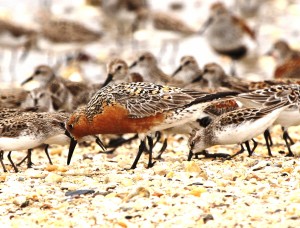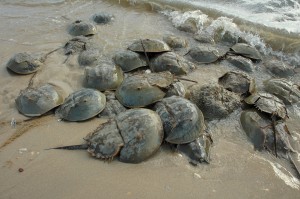Red Knots Return
By Kirsten Werner, Director of Communications

Red Knots at Raybins Beach
Photo: Brian Johnson, preserve manager
In the 1920s, Rear Admiral Richard Byrd made aviation history with his flights over both the North and South Poles, earning him medals and accolades. But a different bird—one weighing less than an iPhone—is the real master of long-distance flight. With one of the longest migration paths in the animal kingdom, the Red Knot flies nearly pole to pole and back every year of its life.
Red Knots are migratory shorebirds in the sandpiper family. They spend their winters in Tierra del Fuego, the southernmost point of South America, wading along the tidal beaches to forage for clams and other mollusks. But when February arrives, these birds embark on a journey to their spring breeding grounds above the Arctic Circle. Traveling in flocks of thousands, the Robin-sized birds fly more than 9,300 miles to lay their eggs in shallow nests built on the sparsely vegetated tundra.
About halfway along their spring trek, the Red Knots make a critical stopover to Delaware Bay—including Raybins Beach at our Glades Wildlife Refuge—to refuel before continuing on. In fact, an estimated 90 percent of the entire species population can be found on the Bay in a single day. The birds arrive near emaciation and spend about two weeks feeding, gaining up to 10 percent of their body weight each day, until they are able to resume their trip to the Arctic.
A key component of the Red Knot diet is the eggs of Atlantic horseshoe crabs and Delaware Bay is home to the largest population of these prehistoric creatures. Every May and June, in a coincidence of timing that only nature could orchestrate, hundreds-of-thousands of horseshoe crabs leave the ocean depths to spawn on the moonlit beaches. The eggs, full of fat and protein, are the ideal fuel for hungry Red Knots, which have lost up to half their body weight by the time they arrive at the Delaware Bay.

Spawning horseshoe crabs at Raybins Beach
Photo: Bill Moses, volunteer
Most of the eggs the birds consume have been damaged or disturbed by waves and storms, so their ravenous feeding does not have a significant adverse affect on the breeding success of the crabs. These remarkable creatures—more related to scorpions or ticks than crabs—have evolved little over the last 250 million years. Yet they have survived thanks in part to their hard, curved shells, which make it difficult for predators to overturn them and expose their vulnerable underbellies, their tolerance of extremes in water temperature and salinity, and their ability to go more than a year without eating.
However, the population of horseshoe crabs has declined. Over the last hundred years, millions of these animals have been harvested: used for fertilizer and hog fodder; as bait for eel, conch, and whelk; or for biomedical research. And loss of spawning habitat as coastlines are developed has also taken its toll on the species. Between 1990 and 2005, the number of horseshoe crabs plummeted by nearly 90 percent, leaving migrating Red Knots without enough food to survive their journey north.
States began regulating horseshoe crab harvests in the late 1990s. But it wasn’t until a connection was made between the crabs’ decline and a concurrent drop in Red Knot numbers that legislation was enacted. Currently, there is a harvest moratorium in place in New Jersey and tight restrictions on annual harvests in the state of Delaware. Volunteer surveys indicate that the population of horseshoe crabs in Delaware Bay has stopped declining, but only time will tell if this action was taken in time for the remarkable birds that depend on them. The Red Knot is listed by the Fish and Wildlife Service as a Bird of Conservation Concern and considered a Continentally Threatened Species. Recently, it has been named as a “Candidate” for the Endangered Species List.
Raybins Beach, located within Natural Lands Trust’s Glades Wildlife Refuge, is one of the best locations for spotting these birds and spawning horseshoe crabs. Please do not walk on the beach when shorebirds are present and, as always, keep dogs on a leash. You are welcome to study them from a distance with binoculars or a spotting scope.
Glades Wildlife Refuge is an expanse of diverse landscapes: vast tidal marshes, wooded wetlands and uplands, beaches along the Delaware Bay, and a remarkable old-growth forest. By preserving this 6,765-acre property, Natural Lands Trust is, in-turn, helping to protect horseshoe crabs, Red Knots, and other species that rely on its special habitats for their survival.
